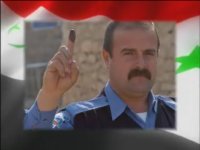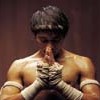Agam's Gecko


Tuesday, March 25, 2008
WHAT REALLY HAPPENED IN LHASA?
| W |
e've all seen the photographs and video aired around the world for the past 10 days, depicting what happened in Lhasa on March 14. Nearly every image of this event has been released by the government of China, which aired extensive footage domestically as part of its "people's war" in a bid to stoke a hyper-nationalist attitude among Chinese people. The government wants to continue to come down hard against its "enemies," and it needs the Chinese people to want that too.
Some small amount of unauthorised video and pictures got out of Lhasa with tourists, but they were soon expelled -- and the few remaining journalists along with them. What we do know is that from the first monks' marches beginning March 10, up until the Ramoche Temple incident on the 14th, the Tibetans were non-violent.
Monks emerged from within the three largest monasteries -- Drepung, Sera and Ganden -- in peaceful but vocal processions. They were confronted and halted by large numbers of security forces, tear gassed, beaten, and shots were certainly fired (whether warning or indiscriminate firing is still a question mark on these early incidents). Some unknown number of monks were arrested and taken away (remember this for later).
The groups of monks involved in these several early incidents, numbering up to six or seven hundred, were forced back into the monasteries, and were then sealed inside by thousands of soldiers surrounding these institutions. No one has heard from them since then. It has been two weeks, they cannot come out, and no food or water is allowed in.
Are the Chinese attempting to starve them all to death? Two weeks is a long time, and naturally the authorities don't want any accounts of what happened to escape those walls either. (The source also confirmed earlier reports that Tibetans injured in the unrest are being denied medical treatment - hospitals and doctors are forbidden from attending to them.)
When some young Lhasans erupted into violence after four days of this, was it because of the long decades of colonial policy, or were they enraged by something more immediate? It may have been both.
During the years just before the end of the Suharto regime in Indonesia, there was a saying I often heard there to describe the situation: When the grass is tinder dry, it only takes one spark. People can be pushed only so far, before they won't take any more.
In the chaotic hours after Lhasa erupted March 14, Tibetans rampaged through the city’s old quarter, waving steel scabbards and burning or looting Chinese shops. Clothes, souvenirs and other tourist trinkets were dumped outside and set afire as thick gray smoke darkened the midday sky. Tibetan fury, uncorked, boiled over.When the riot erupted, the police actually fled away. An American woman wandered through the entire scene of destruction that day, and saw not a single police officer or soldier. How could they have been so unprepared, after days of rising tensions with the monks, and using force to keep them from entering the city? The absence of security forces making any attempt to restore order emboldened the crowds, which ran completely free through the city.
By this time, at least 60 monks had already been detained by police in the earlier confrontations, according to information gathered by the Times.
I have to take a small issue with one passage in Jim Yardley's article.
Lhasa now has created far more than a public relations problem for Beijing. It has unleashed widespread Tibetan resentment over Chinese rule. Antigovernment demonstrations have spread to Tibetan areas of western China.You mean to say, the Chinese-administered areas of eastern Tibet. OK, I'm being picky.
The images now being constantly broadcast to Chinese people is having the desired effect, ramping up nationalist anger against Tibetans. Many Han people can't stand it when their little minority brothers don't submit happily to their rule, and they're lashing out in internet chat rooms as well as in reported incidents of verbal and physical abuse against Tibetans and Buddhist monks in far distant Chinese cities.
The article says that many rumours and unconfirmed accounts had been circulating among Tibetans prior to the riot, including that Buddhist monks and nuns had already been killed. With the large outlying monasteries sealed off, a confrontation at the inner city's Ramoche Temple drew a large crowd, and this crowd became angry when police clashed with the Ramoche monks. A "massive group" of Tibetans attacked the police, who fled to safety. The riot was on. The American woman said, "This wasn’t organized, but it was very clear that they wanted the Chinese out."
Mr. [James] Miles, the journalist, found himself the only Western reporter on the scene. He spent the next several hours carefully walking around the old Tibetan quarter as rioters burned buildings and overturned cars. "I was looking around expecting an immediate, rapid response," he said. "But nothing happened. I kept asking people, 'Where are the police?' "Chinese police are not trained to "sit back and let a riot burn itself out," says Murray Scot Tanner, a China analyst with a specialty in policing.
The slack response lasted only 24 hours, and the paramilitary crackdown came with full force on March 15. What was going on during that 24 hours? Evidently, the police were there -- they were just otherwise occupied.
Tibetans also say the security forces were unusually passive at the beginning. One monk reached by telephone said other monks noticed that several officers were more interested in shooting video of the violence than stopping it. "They were just watching," the monk said. "They tried to make some videos and use their cameras to take some photos."Police were fully capable of being tough on processions of monks chanting and waving flags. One would expect them to be more concerned with actual violent rioters. But their first priority was to get lots of pictures. These are the only pictures of the event now carried by international photo wire services. They have released no pictures of the crackdown that followed this 24 hour period of collecting the images they wanted.
The Epoch Times (yes, an anti-communist Chinese newspaper / Chinese exile media in other words) has spoken to a former highly placed CCP official who now lives in Taiwan. Ruan Ming says the events in Lhasa were carefully staged by the Party. Mr. Ruan had formerly worked for the General Secretary of CCP, Hu Yaobang, a reformer whose death in 1989 led to the pro-democracy demonstrations by the students' movement that year.
"The demonstration on March 10 was meant to be peaceful. You can see from the pictures that the demonstration was all monks," Ruan explained.But, he says, the Party missed something. While all the pictures from Lhasa came from the CCP's own propaganda war, they didn't expect pictures of their killings to emerge from Tibetan areas hundreds of miles away.
"The CCP arrested some of these monks and killed them. The killing angered some young Tibetans. By March 14, the Tibetans could no longer stand the killing of innocent monks and protested."
According to Ruan, when the young Tibetans reacted, they fell into the CCP's trap.
"The CCP seized this opportunity and took pictures of these Tibetans in violent actions and sent out officers to do a door-to-door search, calling on the 'guilty' to surrender themselves." [my emphasis]
Mr. Ruan believes his former comrades have carefully designed the Lhasa event to label all Tibetans as terrorists, and to frame and sideline Dalai Lama for stirring up trouble.
"This is exactly like how the CCP framed Zhao Ziyang for the Tiananmen Massacre in 1989 and accused Zhao of 'splitting the Party and supporting unrest.' "Accounts other than the Party versions are hard to come by. A Tibetan exile who maintained contact with friends and family in Lhasa and elsewhere has shared his diary with the UK's Daily Express. Wai to Precious Metal blog.
[...]
"If the CCP opens up Tibet for foreign media, someone brave has got to talk. I don't believe there wasn't a single picture taken during the suppression.
"Why did the CCP need to do a door-to-door search right after the suppression? They fear there were pictures taken during the suppression and don't want them to leak out and circulate around."
"I scribble down the words of my best friend from Lhasa when he phones me after taking part in the uprising demonstration.Note the dates prior to the outbreak of rioting on the 14th. He also has accounts of the suppression in eastern Tibet regions.
"He tells me, 'The situation is terrible here. They are shooting at us. Please ask Tibetans outside Tibet not to stop their peaceful march to Tibet. We will not stop demonstrating inside Tibet, even if they take our lives.' " - Tuesday 11th
[...]
"I listen in while a friend in Dharamsala (India) talks to a contact in Lhasa. His friend is a police officer and he says there is a list of more than 100 demonstrators killed, and that more than 500 have been arrested and are being detained.
"He also says there is a discussion going on about whether to secretly kill some of the 500 people that were arrested." - Thursday 13th











 Our way of saying "thanks" in the Thai way. Here a nak muay Thai (kickboxer) offers respect and thanks for his teacher (wai khru) before a match. This is our local variation on the ubiquitous "hat tip" used in general blog culture.
Our way of saying "thanks" in the Thai way. Here a nak muay Thai (kickboxer) offers respect and thanks for his teacher (wai khru) before a match. This is our local variation on the ubiquitous "hat tip" used in general blog culture.








